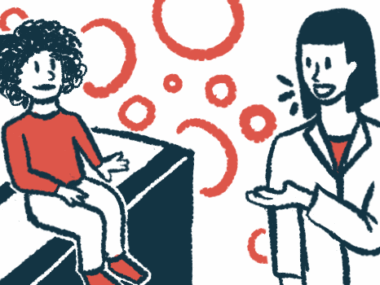AAN 2023: Children reaching motor milestones 10 years after Upstaza
Trial data support long-term safety and effectiveness of the gene therapy
Written by |

Children with aromatic L-amino acid decarboxylase (AADC) deficiency are continuing to experience motor function gains up to 10 years after receiving a single dose of PTC Therapeutics’ gene therapy Upstaza (eladocagene exuparvovec), new clinical trial data show.
Alexis Russell, PTC’s senior medical director, discussed the findings during last week’s American Academy of Neurology (AAN) annual meeting, in a talk titled “Eladocagene Exuparvovec Gene Therapy Improves Motor Development in Patients With Aromatic L-Amino Acid Decarboxylase Deficiency.”
AADC deficiency is caused by mutations in the DDC gene, which encodes AADC, an enzyme that is needed to make key neurotransmitters, or signaling chemicals that nerve cells use to communicate.
Impaired production of these neurotransmitters results in neurological symptoms, such as failure to reach developmental milestones, movement issues, dysregulation in involuntary bodily processes, and seizures.
Upstaza delivers healthy version of DDC gene to brain cells
Upstaza is a gene therapy designed to deliver a healthy version of the DDC gene to cells in the brain; it is administered directly into the brain through a surgical procedure. Last year, it became the first approved disease-modifying therapy for AADC deficiency in the European Union and in the U.K.
PTC is planning to apply for approval in the U.S. in the coming months, Russell said.
Upstaza was first tested in children with AADC deficiency within a clinical trial in Taiwan that began in 2010. It has also been tested in pediatric patients in a Phase 1/2 trial dubbed AADC-010 (NCT01395641) and a Phase 2b study called AADC-011 (NCT02926066), both also conducted in Taiwan.
A total of 30 patients were treated with Upstaza across these three single-center studies, with many of them currently being followed for at least 10 years in a long-term extension study.
At the time of treatment, the children’s ages ranged from 19 months to 8.5 years, though 56.7% of them were younger than 3 years when they received Upstaza. A little more than half of the children were boys, and most were Asian.
All children carried a specific disease-causing mutation, called c.714+4A>T, that is associated with little to no production of the AADC enzyme and, therefore, severe disease. This mutation is common among AADC deficiency patients in South Asia, particularly in Taiwan.
Prior to receiving Upstaza, none of the children had achieved any motor milestones, such as having head control or the ability to sit up.
Three months after the gene therapy (the earliest point assessed), three of the children were able to fully control their heads, and one was able to sit unassisted. At one year, 15 of the children showed head control, eight could sit unassisted, and two were starting to stand.
These kids are starting to get stronger and develop these motor milestones, they’re developing coordination and they’re also developing the cognitive ability to understand what the examiner is asking of them.
Children reached motor milestones rarely seen in people with AADC deficiency
Over subsequent years of follow-up, more of these children attained milestones in motor development that are rarely seen in AADC deficiency patients.
“As we look at two, three, four, and even five years after gene therapy administration, we see subsequent development of even more difficult motor milestones, like being able to walk fully independently to a toy, being able to walk up stairs with support, being able to walk backwards, walk down a taped line,” Russell said.
“To me this not only talks to the fact that these kids are starting to get stronger and develop these motor milestones, they’re developing coordination and they’re also developing the cognitive ability to understand what the examiner is asking of them,” she added.
Four of the children have so far been followed for up to a decade, and “even between that five- and ten-year timepoint, we are seeing achievement of more and more motor development,” Russell said, noting that this highlights the therapy’s durability.
Analyses of individual participants have suggested that, generally, the most pronounced improvements in motor development were seen among children who were treated at younger ages.
While the magnitude of improvement was sometimes less dramatic for older children, every patient showed improvement in motor development following the gene therapy, Russell said.
One year after treatment, most of the children, who were underweight before Upstaza, maintained (56%) or gained (42%) weight. One child lost weight following Upstaza. These data suggest the gene therapy may help improve the growth of children with AADC deficiency, Russell said.
Upstaza was generally well-tolerated
Rates of respiratory infections and oculogyric crises (OGCs), both of which are common problems for children with AADC deficiency, also decreased markedly in the years following Upstaza treatment.
Oculogyric crises “are probably one of the worst aspects of the disease that have been reported by parents,” Russell said, and “we also anecdotally know that many of these children go on to have resolution of their OGCs, or such a dramatic reduction in duration and severity that it’s not impacting any of their activities of daily living.”
The therapy was generally well-tolerated, with the most commonly reported adverse events being fever, dyskinesia (jerky, uncontrolled movements), and upper respiratory infection.
Given that dyskinesia develops due to increased activity of dopamine, a neurotransmitter that’s usually lacking in AADC deficiency, its occurrence in Upstaza-treated children “is a signal for us that the gene therapy is starting to work,” Russell said.
She also noted that this side effect usually goes away about three to seven months following treatment, and is generally less severe and less prolonged in younger patients than in older patients.







